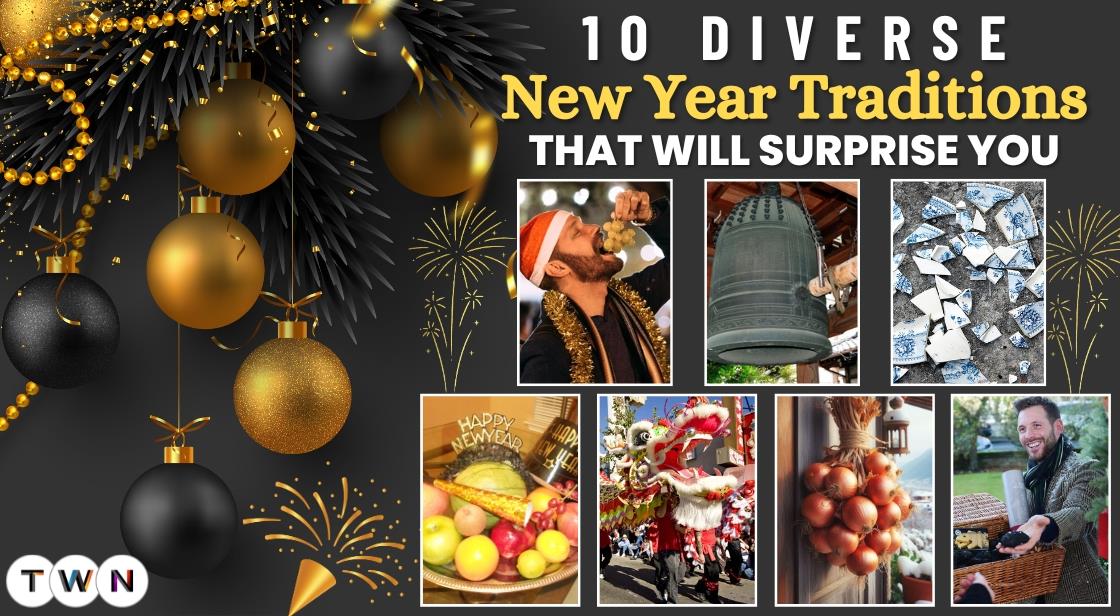10 Diverse New Year Traditions That Will Surprise You

Blog Post
New Year's celebrations are a universal occasion marked by reflection, renewal, and the anticipation of fresh beginnings. While the essence of this festive time remains similar across cultures, the traditions that accompany the transition into a new year vary widely.
From joyous feasts to symbolic rituals, each country offers a unique way to embrace the hope and promise of a new start.
Each country and culture welcomes the New Year in its own way, reflecting their historical, religious and cultural heritage. At the start of the New Year 2025, celebrations around the world not only symbolize joy but also a wish for new hope and prosperity.
In this blog, we will explore some of the most fascinating New Year’s traditions from around the world, each offering a glimpse into the rich cultural tapestries of different nations and their shared desire for happiness, prosperity, and good fortune in the year ahead.
Whether it's Spain's twelve grapes of luck, Japan's ringing bells, or Colombia's suitcase ritual, these customs provide a vibrant look at how the world celebrates new beginnings.
10 Countries That Celebrate New Year Differently: Unique Traditions to Explore
Universal Significance of New Year’s Celebrations
The New Year marks a fresh start, offering a chance for reflection, renewal, and the anticipation of new opportunities. Across the world, it is celebrated as a time to bid farewell to the past year and embrace new beginnings. Whether it’s through reflection, family gatherings, or grand festivities, New Year’s celebrations bring people together, creating a shared sense of hope and joy for the future.
Traditions Vary Across Cultures
What makes New Year celebrations even more fascinating is the diversity of traditions that emerge from different cultures. Each country brings its unique customs, beliefs, and ways of marking the end of one year and the beginning of another. Some traditions are rooted in centuries-old customs, while others are influenced by local folklore or religious practices. These rituals can range from solemn observances to joyous, exuberant celebrations, showcasing how various societies express their hopes and wishes for the coming year.
1. Spain – The Twelve Grapes of Luck
The Tradition of Eating Twelve Grapes at Midnight
In Spain, the New Year’s Eve celebration is incomplete without the tradition of eating twelve grapes at the stroke of midnight. Known as "Las Doce Uvas de la Suerte" or "The Twelve Grapes of Luck," this custom symbolizes good fortune and prosperity for the year ahead.
As the clock strikes twelve, Spaniards eat one grape with each chime, making a wish for the upcoming year. The practice requires precision and speed, often resulting in laughter and lighthearted moments as people try to finish the grapes in time.
The Origin of the Twelve Grapes Tradition
The tradition dates back to 1909 in Alicante, a region in southeastern Spain. Local grape farmers promoted the custom to sell surplus harvests, turning an economic necessity into a beloved national ritual. Over time, it became a widespread cultural practice embraced by families across the country.
Why It’s a Beloved Custom in Spain
The Twelve Grapes tradition is cherished for its sense of togetherness and hope. Families and friends gather to partake in this lighthearted ritual, uniting in shared wishes for happiness, health, and prosperity. It also reflects Spain’s deep connection to its agricultural heritage, particularly its famous grape-growing regions.
Today, the custom extends beyond Spain, with many Latin American countries adopting it as part of their New Year’s celebrations, making it a timeless symbol of good luck and optimism.
2. Japan – Ringing of the Bells
Ringing Temple Bells 108 Times
In Japan, New Year’s Eve is celebrated with a serene and meaningful Buddhist tradition known as Joya no Kane. At temples across the country, large bells are rung exactly 108 times. This number represents the 108 earthly desires or temptations that lead to human suffering, as per Buddhist beliefs. Each chime symbolizes the removal of one desire, helping individuals start the New Year with a pure heart and mind. The solemn yet hopeful atmosphere of this practice is a striking contrast to the revelry often associated with New Year celebrations globally.
Toshikoshi Soba – A Bowl of Longevity
Another cherished Japanese custom on New Year’s Eve is eating Toshikoshi Soba, or “year-crossing noodles.” These buckwheat noodles, typically served in a warm broth, symbolize longevity and resilience. The long, unbroken strands represent a long life, while the ease of cutting the noodles signifies letting go of the past year's hardships. Families and friends gather to enjoy this simple yet meaningful meal, reflecting on the year gone by and looking forward to the future.
A Unique Blend of Reflection and Renewal
Japan’s New Year traditions blend spiritual reflection and culinary symbolism, emphasizing the values of cleansing, gratitude, and renewal. Whether it’s the resonating sound of temple bells or the comforting taste of soba noodles, these customs invite both introspection and hope, making the Japanese New Year celebration truly unique and inspiring.
Also Read: Top Financial New Year’s Resolutions to Secure Your Future in 2025
3. Denmark – Smashing Plates for Good Luck
Smashing Plates: A Unique Danish Tradition
In Denmark, one of the most intriguing and joyous New Year traditions is the act of smashing plates on the doorsteps of friends and loved ones. This quirky custom symbolizes affection, camaraderie, and good luck for the year ahead. The more broken plates you find at your door, the more popular and loved you are believed to be. It’s a heartwarming way to connect with friends and family while wishing them success and happiness.
The Symbolism Behind the Tradition
The act of breaking plates is more than just a fun activity; it carries deep symbolic meaning. Shattering the old represents breaking away from past troubles and creating space for new opportunities and prosperity. It is seen as a way to let go of negativity and embrace the possibilities of the coming year.
Other Fun New Year Customs in Denmark
Apart from smashing plates, Danes also leap into the New Year—literally! It’s a tradition to jump off chairs at the stroke of midnight. This playful ritual symbolizes leaving behind the old year and leaping into the new one with energy and enthusiasm. Additionally, Danes celebrate with lavish feasts, fireworks, and champagne, ensuring the New Year begins on a festive note.
A Celebration of Togetherness and Hope
These traditions reflect Denmark’s strong sense of community and optimism. They showcase the Danish spirit of creating meaningful connections while welcoming the future with open arms and joy.
4. Brazil – Offering Gifts to Yemanjá
Brazil’s Unique New Year Tradition: Honoring Yemanjá
Who is Yemanjá?
Yemanjá, often referred to as the "Queen of the Ocean," is a revered sea goddess in Afro-Brazilian religions such as Candomblé and Umbanda. She symbolizes motherhood, fertility, and the nurturing power of water, making her a central figure in Brazilian culture.
The Tradition of Offering Gifts
On New Year’s Eve, thousands of Brazilians flock to beaches, particularly in Rio de Janeiro, Salvador, and other coastal cities, to pay homage to Yemanjá. Devotees prepare offerings, including flowers, perfumes, candles, and small boats filled with symbolic items, which are then floated into the sea as gifts to the goddess. These offerings are believed to bring blessings, protection, and prosperity for the coming year.
Dressing in White for Peace and Purity
A striking aspect of this tradition is the attire. People dress in white, symbolizing peace, renewal, and spiritual cleansing. This custom reflects the collective desire to start the New Year with harmony and a clean slate.
Beach Gatherings and Rituals
As midnight approaches, the beaches become vibrant with music, dance, and prayers dedicated to Yemanjá. Many participants jump over seven waves, a ritual thought to attract good luck. The atmosphere is one of reverence and celebration, blending spirituality with festivity.
This unique tradition highlights Brazil’s rich cultural tapestry and the deep connection between its people and the sea.
5. Philippines – Round Objects and Prosperity
The Symbolism of Round Objects
In the Philippines, round objects are considered symbols of prosperity, wealth, and good fortune. This belief is rooted in the round shape, which represents coins, abundance, and financial stability. As Filipinos welcome the New Year, they embrace this tradition to attract economic success and positivity in the coming year.
Wearing Polka Dots for Good Luck
One of the most popular customs is wearing polka-dotted clothing on New Year’s Eve. The round pattern is believed to invite wealth and prosperity. Families often dress in outfits featuring polka dots to align themselves with the spirit of abundance, ensuring that the New Year starts with optimism and hope.
The Feast of Round Fruits
Another cherished tradition involves preparing and displaying round fruits on the dining table. Families aim to collect 12 different kinds of round fruits, symbolizing each month of the year. Common choices include oranges, apples, grapes, and watermelons. These fruits are not only a visual representation of wealth but are also enjoyed during the New Year feast, ensuring that the symbolism is both meaningful and festive.
A Tradition of Joy and Positivity
These customs highlight the Filipino culture's emphasis on joy, hope, and shared prosperity. Whether it’s through fashion or food, the focus remains on starting the year with optimism and unity, making the Philippines’ New Year traditions both unique and heartwarming.
6. Scotland – First-Footing
Introduction to First-Footing
First-Footing is a cherished Scottish New Year tradition that symbolizes luck and prosperity for the coming year. This practice involves the first visitor, or "first-footer," entering a home after midnight with symbolic gifts. The gifts, such as coal, shortbread, or whiskey, represent warmth, food, and good cheer, ensuring the household's fortune for the year ahead.
The Role of the First-Footer
The first-footer holds great importance in this tradition. Ideally, the first-footer is a dark-haired male, as per Scottish superstition, which dates back to Viking times when fair-haired strangers were seen as bad omens. The visitor is expected to bring positivity, carrying the symbolic gifts while stepping into the house with their right foot first.
The Significance of Hogmanay
Hogmanay, the Scottish celebration of New Year’s Eve, is deeply rooted in Scottish culture and history. While Christmas was subdued for centuries in Scotland due to religious reform, Hogmanay emerged as the major festive occasion. Communities come together to celebrate with torchlight processions, music, and traditional dances, followed by the First-Footing ritual.
Modern Celebrations and Community Spirit
Today, First-Footing is as much about preserving cultural heritage as it is about fostering community bonds. Families and friends gather to welcome the New Year, sharing food, drinks, and laughter. The tradition serves as a reminder of Scotland’s rich history and its enduring sense of togetherness.
7. South Africa – Throwing Furniture Out the Window
A Quirky Tradition of Letting Go of the Past
In South Africa, particularly in some neighborhoods, there’s a fascinating and somewhat quirky tradition of throwing old furniture out of windows on New Year’s Eve. This act is believed to symbolize the desire to rid oneself of old, unwanted baggage—both literally and figuratively—making way for new opportunities and fresh starts in the upcoming year.
Cultural Significance
This tradition is rooted in the idea of cleansing, renewal, and leaving behind any negative energy or challenges from the previous year. By physically discarding old furniture, South Africans believe they are releasing the weight of the past, both in their homes and in their lives. This practice is often seen as a way to invite positive energy and success for the coming year.
Community and Neighborhood Practices
While this tradition might seem unusual to outsiders, it is often done in a fun and festive manner within specific communities, especially in urban areas. People may throw out old couches, chairs, and tables, often accompanied by fireworks, music, and celebration. It’s a shared ritual that brings people together in their efforts to start anew and transform their surroundings.
A Symbol of Transformation
Ultimately, this unique South African custom emphasizes the importance of letting go of the past to embrace new beginnings. While the furniture-throwing may be more symbolic than practical, it is a deeply meaningful tradition for many, offering a sense of closure and optimism as they enter a new year.
8. Greece – Hanging Onions
In Greece, one of the unique New Year traditions is the hanging of onions on doors. This custom is symbolic of new beginnings and growth. Onions, with their many layers, represent the potential for renewal and rebirth in the coming year. By hanging onions on their doors, Greek families invite prosperity and the opportunity for personal growth. The onions are often placed there on New Year's Eve and remain there until the morning, offering a visual reminder of the fresh start the New Year brings.
The Tradition of Smashing Pomegranates for Good Luck
Another fascinating tradition in Greece is the smashing of pomegranates to ensure good luck in the coming year. As part of the New Year's celebration, the head of the household takes a pomegranate and strikes it against the floor or a wall, breaking it open. The pomegranate is believed to symbolize abundance, fertility, and good fortune, with the many seeds representing the hope for a fruitful year ahead.
The more seeds that spill out, the more luck and prosperity are believed to come to the family in the New Year. This tradition is deeply rooted in ancient Greek culture and is often accompanied by wishes for health and success for all members of the family.
Together, these traditions highlight the Greek belief in renewal and positive change as they welcome the new year, using simple but powerful symbols of growth and good fortune.
9. Colombia – Carrying Suitcases
In Colombia, one of the most fun and light-hearted New Year’s traditions involves walking around with an empty suitcase. This custom is believed to bring good luck and invite travel opportunities for the coming year. It is especially popular in Colombia’s cities and rural areas alike, where families and friends gather to celebrate the turn of the year.
Symbolism of the Empty Suitcase
The empty suitcase represents the wish for adventure and new journeys. Colombians carry it around the block or even make laps around their homes just after midnight. The act of carrying an empty suitcase is seen as a symbolic gesture to manifest travel dreams, whether for vacations, business trips, or new life experiences. It’s a playful and hopeful tradition that fosters positive thinking and the excitement of new beginnings.
A Light-Hearted and Hopeful Tradition
Unlike other solemn customs, this tradition is all about fun and optimism. It reflects the Colombian culture's joyful and energetic nature, focusing on the hope of new experiences and exploration in the upcoming year. It’s a light-hearted way to celebrate and remain positive about the future, offering a moment to reflect on the possibilities ahead while bringing smiles and laughter.
10. China – Lunar New Year Celebrations
Chinese New Year, also known as the Spring Festival, follows the lunar calendar, unlike the Gregorian calendar used in much of the world. The date of Chinese New Year varies each year but typically falls between January 21 and February 20. It is celebrated on the first day of the Chinese lunar calendar, marking the start of the new lunar year.
Dragon Dances and Festivities
One of the most iconic traditions during Chinese New Year is the dragon dance. This spectacular performance involves a team of dancers holding up a long, colorful dragon puppet that weaves and moves through the streets, symbolizing strength, good fortune, and the driving away of evil spirits. The dragon dance, accompanied by loud drumming and firecrackers, is believed to bring prosperity and good luck for the year ahead.
Red Envelopes (Hongbao)
Another popular custom is giving red envelopes, or hongbao, filled with money to children, unmarried adults, or elderly relatives. The red color symbolizes luck and happiness, and the money inside represents a wish for good fortune in the coming year. It is common for families to exchange these envelopes during visits and celebrations.
Elaborate Feasts
Chinese New Year is also marked by grand family feasts, with traditional dishes that carry symbolic meaning. Foods such as dumplings (representing wealth), fish (for abundance), and sticky rice cakes (for a higher income or position) are often served, bringing blessings for a prosperous year ahead.
These traditions, deeply rooted in culture and history, make Chinese New Year a time for family reunions, joy, and the celebration of new beginnings.
Conclusion: Embracing Global New Year Traditions
New Year’s celebrations are a universal occasion, marked by the shared desire for renewal, reflection, and hope. However, the diverse ways in which people around the world usher in the new year highlight the rich cultural variations that make this time of year so unique and fascinating. From the solemn bell ringing in Japan to the quirky plate-smashing tradition in Denmark, each custom reflects the values and aspirations of the people who practice them.
While the traditions may differ, the common theme of optimism and the desire for a fresh start binds these celebrations together. Whether it’s offering gifts to deities, symbolizing wealth with round objects, or carrying empty suitcases for travel, these practices remind us that the New Year is not just about celebrating the passing of time, but also about setting intentions, embracing growth, and welcoming new opportunities.
You May Like
EDITOR’S CHOICE












